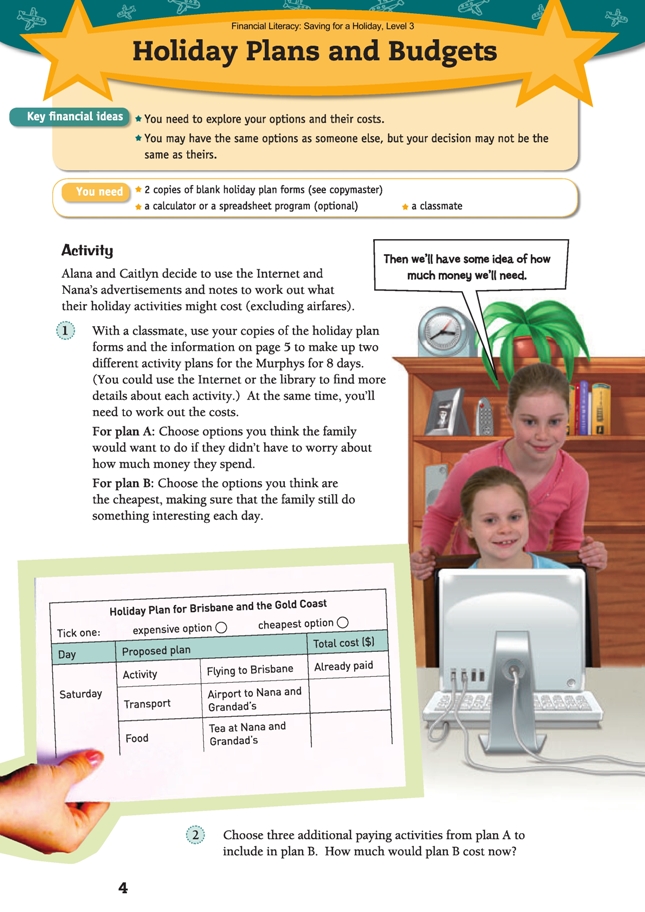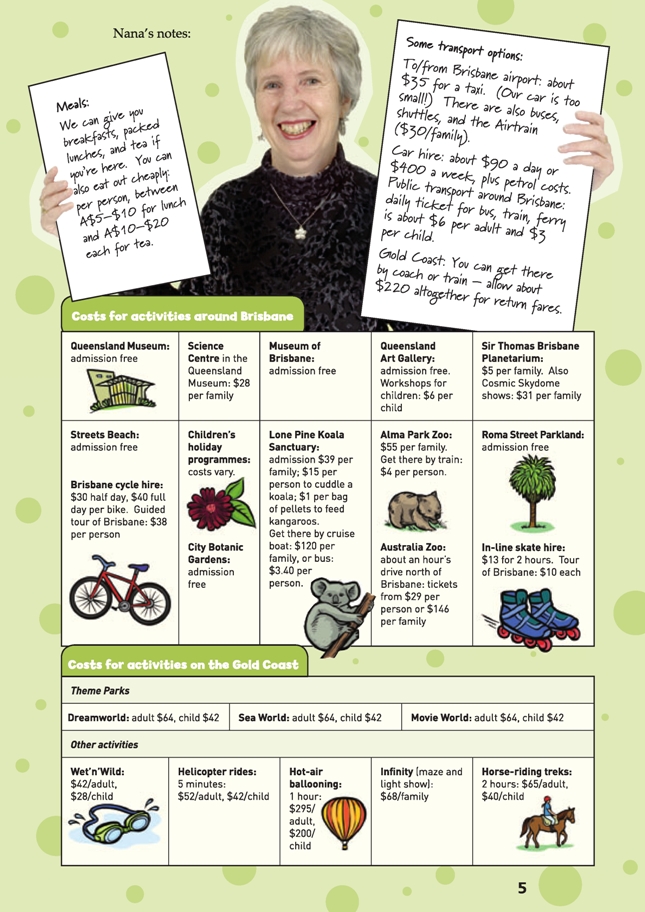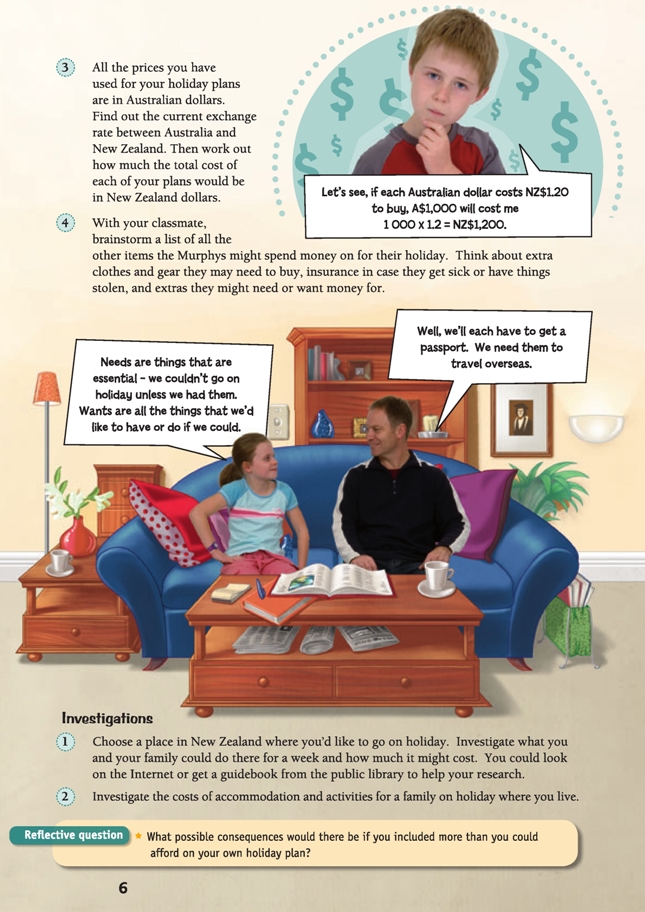This is a level 3 number and statistics activity from the Figure It Out series. It relates to Stage 6 of the Number Framework.
A PDF of the student activity is included.
Click on the image to enlarge it. Click again to close. Download PDF (3408 KB)
use mental strategies to calculate costs
calculate an exchange rate
Number Framework Links
This activity involves the addition of money, entering financial data in a table, and converting currencies.
Students could use stage 6 strategies to add up the cost of the holiday plans, but the calculations could get long and repetitive and the students may lose interest in the financial literacy aspect. Students will be more willing to change and adapt their plans if they have calculators readily available. They could also use a spreadsheet, with appropriate formulae. (See page 24 of these notes.)
Students working at stage 7 should be able to understand the concepts involved in converting the costs to New Zealand dollars in question 3. To prepare them for the concepts involved in comparing ratios and proportions in currency conversions, see the table of NDP material on page 4.
A calculator of a spreadsheet program (optional)
FIO, Level 3, Financial Literacy: Saving for a Holiday, Holiday Plans and Budgets, pages 4-6
A classmate
Mathematics and statistics
In this activity, students work out how much it might cost the family for 9 days on holiday (excluding airfares), depending on which options are chosen out of a range of choices.
Some students may be put off by the amount of reading in this activity. If so, you could have all the students look at the choices available on page 5, skim-read them, and then either share one they’d like to do if they went to Brisbane or find one that they think looks interesting that no one else might have noticed. If anyone has
visited Brisbane, get them to share their favourite memories. They could also do some Internet research on what places such as the Queensland Museum offer (for example, their Dinosaur Garden).
Then show the students the blank holiday plans form (see copymaster, page 46) and talk through what they will need to record for plan A and plan B.
Encourage the students to use “reverse estimation” when they use a calculator, that is, to look at their calculator answer and decide whether or not it is sensible. Use of a calculator doesn’t guarantee a correct answer; pressing the wrong keys or using an incorrect equation can happen at any time!
For question 3, a mathematical skill that the students may have difficulty with is converting the cost of the holiday plans from Australian dollars to New Zealand dollars. The students may not be aware that different countries use different currencies and that one of our dollars is not necessarily worth the same as another
country’s dollar or whatever is the base denomination, for example, pound (United Kingdom), ringgit (Malaysia), shilling (Kenya), and rand (South Africa). The exchange rate is the mathematical calculation that matches up the currencies of any two countries. Simplify the problem for students with the following scenario:
Imagine we are going to the land of Vanark, where you buy things using varks. If you give the Bank of Vanark four of our dollars, they will give you two varks in exchange so that you can buy things in the Vanark shops.
How much would you need to give the Bank of Vanark if you wanted to buy just one vark? ($4 ÷ 2 = $2)
How many dollars would you need to give the Bank of Vanark if you wanted to buy five varks? (5 lots of $2 = $10)
Use a ratio table to predict how much of our money you’d need to buy these varks:
Using the information that one vark is worth $2, what would you do to work out how many dollars you need to buy 1 000 varks? (If 1 vark : 2 dollars, then 1 000 varks : 2 x 1 000 dollars = 1 000 varks : 2 000 dollars)
How much New Zealand money would you need to buy one Australian dollar? (The rate varies from day to day, so do an Internet search on “currency exchange” + Australia + New Zealand to find a currency converter or use the newspaper to find the rate.)
Can you use this information to work out how much New Zealand money you would need to buy 20 Australian dollars?
If A$1 : NZ$1.20, then, A$20 : NZ$? What did you do to work it out? (If each Australian dollar costs $1.20 in New Zealand dollars to buy, you would need 20 lots of NZ$1.20 to buy 20 Australian dollars. 20 x $1.20 = $24.00)
If your holiday plan costs $4,350 Australian, what would you do to work out how many New Zealand dollars it would take to buy $4,350 Australian? (4 350 lots of NZ$1.20, which is 4 350 x 1.20 = NZ$5,220) What would happen if the New Zealand dollar went down in value compared to the Australian dollar between now
and the time the holiday is planned for? How might this affect the cost of the holiday? (It would then cost more New Zealand dollars to buy each Australian dollar, so the cost of the holiday would increase.)
Financial understanding
The information that the students collect, organise, and analyse will be essential for making the best decision for themselves. As students brainstorm lists of possible travel ideas, they are generating, identifying, and assessing opportunities.
After the students have made their plans, get them to work out the difference in cost between their expensive options and their cheapest options. Ask:
What are the positive consequences of spending this extra money on doing all your favourite activities? (You will have fun experiences together as a family, create great memories, learn about new things, and so on.)
What are the negative consequences? (You won’t have that extra money available to use when you get home, – which might affect your ability to pay bills on time; if you borrowed that extra money, you still have to pay it back later; the activities may not be as enjoyable as you had hoped, but the money will be gone, and so on.)
Do you think it’s worth the extra money to do your favourite activities? (This is a good opportunity to point out the key financial idea at the top of the students’ page that people differ in their decisions even though the options [or choices] may be the same.)
For question 4, get the students to brainstorm their lists in small groups and to then use a highlighter to classify which items they would define as wants (desirables) and which ones would be needs (essentials for the holiday to happen). Ask: What is an example of an item that one group might have classified as a need while another group classified it as a want? Can both be justified? (One example might be an item of clothing, such as shoes – it would be a need if you didn’t have any but a want if you already owned several suitable pairs and just wanted a newer pair to take.)
Investigations
Financial understanding
You could invite a travel agent to visit your class for the students to interview about issues involved in planning a New Zealand or overseas holiday.
As further investigations, the students could find out about the currency of another country apart from Australia and share what they find out with the class. Ask What is the standard unit of that currency and how many of them could you buy with one New Zealand dollar? Some students may be able to bring in samples of notes and coins from other currencies left over from their family’s travels.
Have the students track how the New Zealand dollar is valued compared to another currency of their choice for a week or two and investigate possible reasons the dollar might go up or down against this currency.
Students could extend their exploration of currency exchange by investigating The Economist’s “Big Mac index”, which compares how much it costs to buy a standard item in various countries around the world (available on the Internet, updated yearly; search under “big mac index”). Ask Why might it cost so much more or less in different countries to buy the same item? (Labour and resource costs might differ; for example, in some Pacific islands, they have to import the lettuce for burgers, so it costs a lot more; or in some countries they might pay their workers less; there may be scarcity of the item, which drives the price up; the currency might be over- or under-valued.
Social Sciences Links
Achievement objectives:
• Understand how people view and use places differently (Social Studies, level 3)
Have the students explore current issues being debated in the media, for example, use of waterfront land or green-belt development, and debate these issues.
The students could look at an “issue” in school, in the newspaper, on television, on the Internet, and so on, where different perspectives on a place have caused the issue.
• Understand how people make decisions about access to and use of resources (Social Studies, level 3)
The students could discuss:
– why the family might have different perspectives about where they want to go and what they want to do on their holiday
– how these different perspectives could be respected and satisfied
– how these decisions could be made.
Other Cross-curricular Links
English achievement objective:
• Processes and strategies: Integrate sources of information, processes, and strategies with developing confidence to identify, form, and express ideas (Speaking, Writing, and Presenting, level 3)
Activity for students: If you had a family of visitors staying with you for a week, what activity choices would they have in your local area or within convenient travelling distance? Make a brochure that lists some family activities and their cost (you could download pictures from your local information centre or cut up brochures to create your brochure). If you were choosing 3 days’ worth of activities from your brochure, what decisions would you make? Which activities would be good for your class to visit on a school or camp trip?
Answers to Activities
Activity plans and total costs will vary.
Plan A: If you chose expensive activities to do each day, such as hot-air ballooning, or did two activities in a day, bought most of your lunches, dinners, and snacks, and hired a car instead of taking public transport, this activity plan might cost about A$4,330 (approximately NZ$5,200).
Plan B: If you chose mostly free activities and a few of the cheapest ones in Brisbane (that is, you didn’t visit any theme parks or do extras that cost more money at museums or zoos), took packed lunches, ate other meals at Nana and Grandad’s place, and used public transport daily passes, your itinerary might only cost
about A$640 (approximately NZ$770).
2. Answers will vary.
3. Answers will vary, depending on your choices and the current exchange rate.
4. Answers will vary. Your list might include things such as: passports, travel insurance, suitcases or bags, backpack for day trips, toilet kits, a portable first aid kit, new clothes/jackets/swimming togs, souvenirs, snacks and drinks, presents to thank Nana and Grandad for having them to stay, presents for friends back in
New Zealand, a digital camera.
Investigations
1.–2. Answers will vary.
Reflective question
Answers will vary. Each holiday plan will vary in terms of total cost, the range of activities chosen, and the enjoyment of the holiday. If the amount of money spent is more than your family can really afford (for example, if you use a credit card),
consequences could include having to pay off credit card debt plus interest or not having enough money to pay bills on your return.






